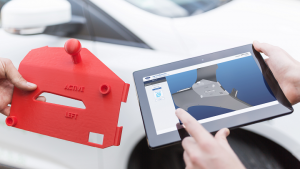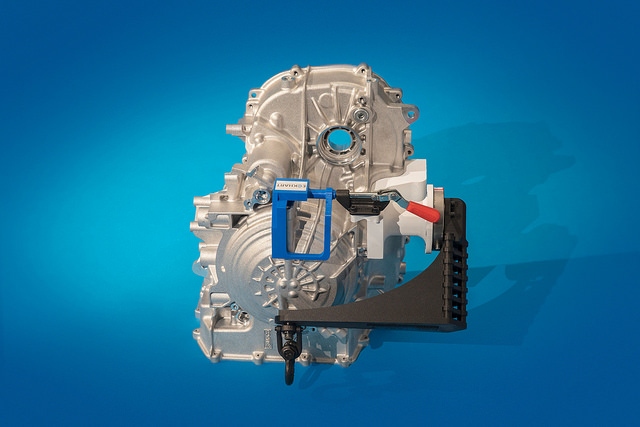Ford and trinckle Partnering to Automate Design of 3D Printed Production Tools
Popular automotive manufacturer Ford, which has long used 3D printing to fabricate assembly tools and was recently recognized for its work with the technology, is now partnering up with award-winning software company trinckle in order to automate the design process for its 3D printed production tools. The two companies will present the joint project next week during formnext.
“The additive manufacturing itself is no longer the dominating cost factor limiting the scalability of the application. Up to 50% of the total costs per tool are caused by the manual design, which is the new bottleneck. For each new line and each special edition, these tools must be specifically designed to position the badges with exact accuracy,” explained Lars Bognar, an engineer with Ford Research & Advanced Engineering Europe. “This design task is not a trivial one, as the tools have to adapt precisely to the free-form surfaces of the car body sheet. It can easily last between two and four hours to create an appropriate AM-ready design. Time that is hard to spend for the designers, who are already working at full capacity. In the worst case, a short-term demand can result in a delay of assembly because the corresponding tools are not available. It was time for us to rethink the design process from scratch, and that’s when we came across the trinckle team.”
 Based in Berlin, trinckle, a 3D printing service and software company, specializes in product configuration and automated design. The company uses its cloud software paramate to create software applications, which can integrate the user into the process, for the automated design of 3D printed products across a wide range of industries, including automotive.
Based in Berlin, trinckle, a 3D printing service and software company, specializes in product configuration and automated design. The company uses its cloud software paramate to create software applications, which can integrate the user into the process, for the automated design of 3D printed products across a wide range of industries, including automotive.
Many automotive manufacturers use 3D printing to fabricate assembly aids and hand tools, like fixtures and jigs. There are many advantages, including lower weight and production costs and faster availability. Ford, which currently has over 50 different 3D printed tools in serial production, is working with trinckle to further scale the applications of the technology.
 Bognar and his fellow engineer Raphael Koch didn’t want to settle for just saving a little money, and decided to, as trinckle put it, look “at the AM application as a whole.” They decided to use a hand tool called a labeling jig, which places model badges on the body of a vehicle, as an example.
Bognar and his fellow engineer Raphael Koch didn’t want to settle for just saving a little money, and decided to, as trinckle put it, look “at the AM application as a whole.” They decided to use a hand tool called a labeling jig, which places model badges on the body of a vehicle, as an example.
trinckle developed an internal application for Ford so it could efficiently generate these tools by creating new jig designs in just minutes. Employees can upload the car body’s model data, and the necessary badges, through an intuitive user interface. Then, with just a click of the mouse, standard elements like edge guides, handles, magnet mounts for fixation, and text fields can be easily added. Software algorithms generate the tool’s geometry so it fits the contour of the car body.
“The trinckle software application does not only dramatically reduce manual design times and costs, but also streamlines the entire process,” said Koch. “We enable our employees on the shop floor to take over more responsibility and relieve our designers at the same time. The latter can focus on their core activities again.”
Now, instead of lasting two to four hours, the design process only takes 10 minutes, thanks to the straightforward handling provided by paramate. Because AM-compliant design expertise is not necessary, assembly line employees can easily design 3D printable tools on their own and independently carry out tool optimization iterations.
 Using automation to design 3D printable labeling jigs is only the first step in the right direction for Bognar and Koch, and in the near future, other additive tools will likely undergo similar automation.
Using automation to design 3D printable labeling jigs is only the first step in the right direction for Bognar and Koch, and in the near future, other additive tools will likely undergo similar automation.
To learn more about this work with Ford, and its other business applications, visit trinckle at booth C07 in Hall 3.0 at formnext in Frankfurt next week. Bognar and Dr. Ole Bröker, the Head of Business Development at trinckle, will also be presenting the joint project at the TCT Conference during the show.
Discuss this story and other 3D printing topics at 3DPrintBoard.com or share your thoughts in the Facebook comments below.
Ford Recognized for Work with Automotive 3D Printing
Several major automotive manufacturers have been utilizing 3D printing, and Ford is one of them. Recently, the company has been recognized for its work in 3D printing. For the first time, the Automotive Innovation Awards Competition held by the Automotive Division of the Society of Plastics Engineers (SPE) is recognizing additive manufacturing as a separate category, and Ford was the winner of all three finalist spots.
The parts that won Ford the finalist spots include a 3D printed injection mold lifter action used in the new Ranger pickup, a window alignment feature used in the 2017 Mustang convertible, and an assembly lift assist used to make the Escape SUV and Fusion sedan. These aren’t production parts – two are used in assembly and one in a tool, but the technology was still integral in the development and manufacturing of the products.
“We really didn’t understand the potential of what the capabilities of this process were going to be,” said Roy Raymer, Ford’s Product Coordinator for Rapid Manufacturing. “It’s incredible.”
The mold insert was developed to solve a problem of inadequate venting; the 3D printed insert has integrated venting channels to allow gas to escape. The design features vents along the top and side of each vane, which, Ford says, improves venting by 100 percent. Manufacturing time was reduced by 70 percent, and the integrated design eliminates the need for a separate grill. The mold is made by Hi-Tech Mold and Engineering.
The window alignment fixture is 3D printed using FDM, with 35 percent short carbon fiber reinforced polyamide. It is 30 percent lighter and cheaper to produce than a traditional welded fixture – it took only 50 hours to build the integrated feature with handles and mounting brackets. The 3D printed fixture integrates pneumatic control, eyelets for a stowage rack, trigger switch housing, ergonomic handles, a gage protector deflector, pneumatic tubing retainers and switch mounts.
The lift assist was also 3D printed using FDM, and according to Ford, it can lift anything from a half shaft to an instrument panel. 3D printing the part allowed for more complex geometries to better interface with the casting, and it cost 50 percent less than a traditional fixture. It also reduced weight by 222 pounds, reducing repetitive motion injuries and making it easier to operate overall. The company also greatly reduced lead time.
Ford began its 3D printing experimentation with an SLA 3D printer for making complex prototypes, and its work has since evolved to using FDM, SLS and 3D sand printing. Like many other automotive companies, Ford has discovered that 3D printing can save time, money, and material, and allow for the the creation of more complex and unique parts. While the examples above are parts used for tools and assembly, it won’t be surprising if Ford soon moves on to using 3D printing for actual production parts. Other companies, like Divergent 3D for example, are using 3D printing to build cars that are more lightweight and efficient, reducing both cost and environmental impact. As the benefits of 3D printing become more evident, we will likely see more and more manufacturers turn to using the technology for actual production, resulting in a significant change to the entire automotive industry.
The winners of the Automotive Innovation Awards Competition will be announced on November 7th.
Discuss this and other 3D printing topics at 3DPrintBoard.com or share your thoughts below.




